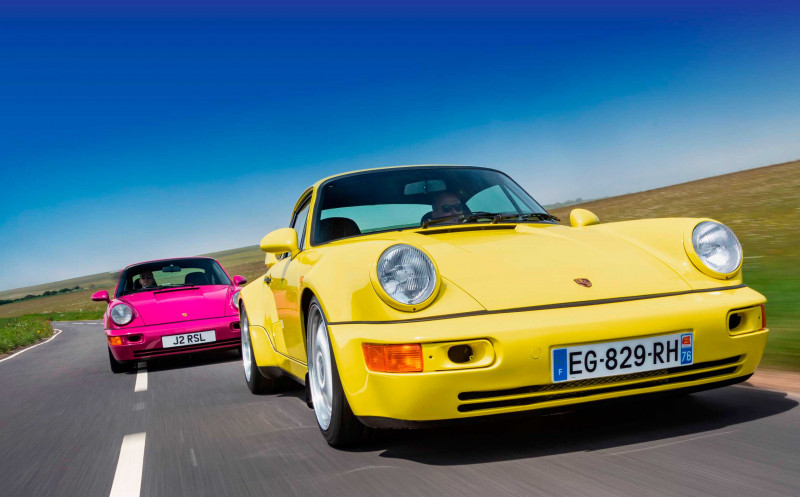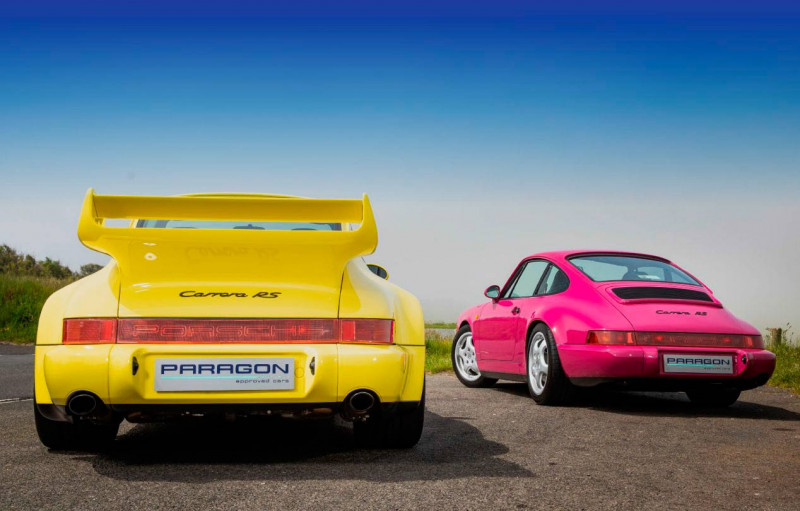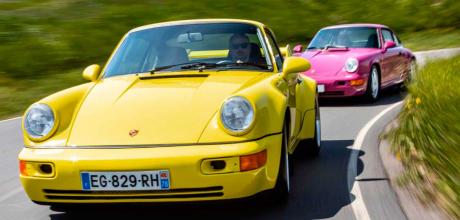Rennsport Legends Porsche 911 RS 3.6 964 takes on the unicorn RS 3.8 964
It’s the test you’ll never likely see on the public road again: Porsche’s halo RS 3.6 takes on the unicorn RS 3.8 in our million-pound 964 clash 964. Written by Kyle Fortune. Photography by Daniel Pullen.
Halo RS 3.6 takes on unicorn RS 3.8 in the million-pound test you’ve never seen before
964 RS legends It’s the ultimate 964 road test as the widely admired RS 3.6 goes head to head with one of only 55 RS 3.8s

The lunacy of the situation isn’t lost on me. Following Mark Sumpter of Paragon Porsche, he approaches a roundabout, there’s a gap in the traffic and he exploits it. We’re on a mission to meet photographer Pullen, and Sumpter’s enjoying the drive. Sumpter’s got masses of space, and he’s through. I’m a few car lengths behind, for good reason, and briefly have to wait for my opportunity to catch up. Not that there’ll be any missing him, as the 964 he’s in is painted in hellgelb, that’s ‘pale’ yellow apparently, and there’s a sizeable wing on the back. A 964 couldn’t be more obvious, its tall rear wing joined by Turbo bodywork, some 18-inch Speedline split rim alloy wheels, and a second exhaust pipe that adds some pleasing symmetry under the lightweight, three-piece rear bumper.
“The 3.6-litre engine is quick and responsive, the steering light and so rich in detail”
The car I’m in isn’t exactly retiring in its hue, either. Rubystone is arguably the colour for 964 RSs but in the present company, it’s positively understated. And common. Sumpter’s car in front might have the same Carrera RS written on its engine cover as the Rubystone example I’m in, but the end plates on the yellow car’s sizeable rear wing, and the numbers they wear, underline that it’s something even more special. A 3.8 RS, one of just 55 road cars built, this RS is second only to the Carrera 4 Leichtbau for rarity among 964s. It’s only the second I’ve ever seen, and all the better for being out on the road rather than secreted away, unused, in a collection somewhere. When Sumpter said he wanted to drive it first I wasn’t disappointed, not least because for comparison purposes it’s always best to get in the lesser, and I use the term reservedly here, car so as not to do it a disservice, but also because I wanted to see this 964 moving.

I’ve driven enough 964 RSs to be familiar with them, many on these same roads, but this Rubystone car is a bit special, even in the current company. There are just over 8,000km on the odometer, Mr Sumpter being kind enough to let us wind on some more for the purposes of this comparison. It feels absolutely box fresh, and if you were to tell me it’d been delivered new the day before I’d have no reason to disbelieve you.
Any 964 RS is special, but this car is among the best, if not the finest out there: the 3.6-litre engine is quick and responsive, the steering light and so rich in detail, the suspension, much maligned as too stiff when reviewed on its launch, being taut and controlled rather than corrupted and compromised. There’s so much road driving it, every 964 making all 911s that have followed it feel bloated in comparison, that being particularly true when RS refinements are added to the mix. The 964’s dimensions make country roads feel like the expansive tarmac of a circuit, the RS’s lightness, just 1,230kg (a not insignificant 120kg less than a Carrera 2), meaning the modest 10bhp gain in power it has over that standard Carrera, for a total of 260bhp, brings a degree of alacrity that’s more marked than the numbers would suggest.
Power has never been the defining factor with the 964 RS. Instead its agility, the 40mm drop in the suspension and the revised geometry that it brings, plus the reduced unsprung masses thanks to its magnesium Cup wheels, all add up to a greater whole. The RS is precise, accurate and engaging, brilliantly so, it very much the epitome of puristic driving. No other firm does incrementation like Porsche, and this RS demonstrates that perfectly. The changes, modest as they all appear in isolation, just add up to a far more focused whole, shedding any slack evident in the standard Carrera and finessing the minutiae to produce something that has to be experienced to be fully appreciated. Those magnesium wheels cover bigger brakes, these allowing you to stand harder, deeper into corners and for less time on the middle pedal, the RS washing off its speed as easily as it gains it. There’s a light deftness to the ‘standard’ 3.6-litre RS, it being hilarious that there was a time when these cars were relatively unloved for a period, because to drive, they’re really special.
I would have happily driven the 300-mile return trip to Paragon just to drive Sumpter’s immaculate 3.6-litre car, but the owner of the 3.8 RS is happy for it to be driven, which given its value is hugely generous. That’ll have to wait for some time though as we’re at Beachy Head, and despite the glorious summer day while following Sumpter here, there’s a mist periodically visiting the coast from the sea. Pullen’s justifiably keen to fill his memory card with the detail shots before it stops play, so patience is the name of the game presently. I’ll get some proper seat time with the 3.8 RS, though that pause is never really unwelcome, because it presents the perfect opportunity to pore over the differences between the two cars as they sit side by side.
The Turbo body is hugely transformative here as an RS, as indeed it was to the Turbo itself. I like a narrow-bodied 911 usually, but the 964 with the Turbo body is so seductively proportioned. Like virtually all of Porsche’s most celebrated drivers’ cars it’s the product of necessity, born entirely thanks to the company’s, and its customers’, desire to race – and win. International motorsport is cyclic, and the 3.8 RS was a direct result of the shift in endurance racing categories globally from Group C racers to more recognisable GT car categories. Porsche wasn’t exactly abundant with riches at the time, it being a turbulent period for the company financially, but the motorsport department was tasked with producing a 911 that customers could race, and race competitively, in the GT class in competition series like the ADAC GT in Germany, BPR Championship and IMSA in the USA, among others.
Spun off the Carrera Cup car, the 3.8 RS was immediately successful, the RSR version going on to win its class at Le Mans, giving the road cars Porsche built to homologate the racers immediate pedigree. There were just 55 road cars built in 1993 (some 45 RSR racers also constructed); this example, being delivered to French Porsche Club President of the time, Philippe Aunay, has the chassis number WPOZZZ96ZPS497064, suggesting it’s the third Porsche made. Like all 3.8 RSs it would run along the production line up to point 6A, before being removed and relocated to the Motorsport department where it was then hand assembled.
The changes over the 3.6 RS are significant, notably the option of the wide Turbo body and a unique, fully homologated rear wing. That engine cover is of composite construction, the wing topping it offering six differing positions, the additional downforce it adds balanced by the spoiler under the front bumper. There’s a second oil cooler up front, while another exhaust joins the right-hand one out back. In usual RS manner, it’s as much what Porsche has removed that defines it as has been added to it. There’s less weight, incredibly, the 3.8 RS shifting some 140kg over the standard 911 Carrera and managing a 20kg reduction over the already paredback 3.6 RS, weighing in at 1,210kg (or 1,140kg without fuel in the enlarged 92-litre fuel tank). To manage that while adding the larger Turbo bodywork sees some necessary revisions, the bonnet and doors being made of aluminium, thinner glass, and the removal of comfort equipment is evident throughout. The wheels, three-piece Speedline alloys, of 9x18 inches on the front and 11x18 inches on the back, wear 235/40 ZR18 front and 295/35 ZR18 rear Michelin Pilot Sport tyres, the original factory items being a choice of Pirelli or Dunlops.
There’s no power steering here; while customers were given the option of an air-bagged wheel, the majority came fitted with the non air-bagged Sports steering wheel, as this one is. Having had it up on a lift, Sumpter says the suspension is largely carried over from the 3.6 RS, though there are five levels of adjustment on the 24mm front anti-roll bar and three on the 21mm diameter rear one. It’s all uniball linked. The spring rates are firmer, as are the dampers, these being gas pressure shock absorbers from Bilstein. Porsche had stated in its press release around the time of the 3.8 RS’s introduction that the race department had “invested a great deal of effort in retaining a comfort component at the same time, thus the RS 3.8 proves equally outstanding for long-distance trips or city traffic.”
The gear ratios remain as the 3.6 RS, though the shift of the G50.10 gearbox has been shortened in its throw, improving speed and accuracy. There’s a single plate reinforced clutch and a ‘weight optimised’ (lightened) flywheel that allows the engine to rev with greater eagerness, while a locking differential from ZF with 40/40 locking was also fitted. The engine attached to all that is a type M64/04 flat six, bored to 3.8 litres (3,746cc, in reality), via an increase from 100mm to 102mm, the stroke remaining at 76.4mm, the bigger pistons being lighter, with revised conrods and a dry sump utilising technology that would be later seen in the 993 Carrera. Reduced back pressure via a pair of exhausts (with catalytic convertors) helped, as did improvements in intake air via hot film technology, and wider intake manifolds feeding the six individual throttle flaps.
All this meant the 3.8 RS in road trim had a quoted output of 300hp at 6,500rpm, torque too increasing over the 3.6 RS to 360Nm at 5,250rpm, the redline for the 3.8-litre increasing to 7,100rpm over 6,700rpm for the 3.6. All that is controlled by Bosch Motronic Type 2.10 engine management. Racers upped that to 350hp thanks to more detailed internal and intake engine revisions, but the road car’s engine components all come stamped with R for Renn (racing), underlining their closeness to their track RSR relatives.
This M004 car does without the Clubsport equipment of the M003 cars, the M004 models accounting for 40 of the 55 road cars built, there being no tubes to clamber over to slip into the snugly fitting bucket seat. The interior is, largely, identical to the 3.6 RS I drove down in, with only the radio delete void being an immediate differentiator in the middle of the dashboard. It’s simple inside, devoid of clutter and clear in its purpose, the three-spoke sports wheel arguably one of Porsche’s finest designs, giving a superb view of the large rev counter with its 7,100rpm redline. Firing up the 3.8-litre engine immediately reveals its Motorsport leanings, it flaring purposefully before settling into a smooth idle, the chatter from the clutch release bearing being clear, with that sound always signifying something special and pure.
The clutch is notably heavier than that of the 3.6 RS, but it’s not a workout, it just needs a firmer push. That’s true of the gearbox, it needing more force to shift it across its shorter throw. Add the steering that’s heavier at slow speeds, thanks to the loss of the power steering, and greater tyre contact patch, and the change in character over the 3.6-litre RS is immediate. It feels more physical, not brutally so, but more force is required to operate it. There’s a muscularity to its controls which, given its purpose of lasting and winning in endurance racing is entirely understandable. If the 3.6 RS feels like a road car that’s been track enabled, the 3.8 RS feels the opposite, being a racer first, with road use a secondary consideration.
That’s not to say it’s a mass of compromise. Quite the contrary. It drives remarkably well for a car that you could have conceivably put some stickers on the doors, changed the tyres for slicks and rocked up to a race meet and driven home with some silverwear. The engine is at its best when it’s above 3,500rpm, it not recalcitrant below it, but lacking a little bit in immediacy, the smaller 3.6-litre in comparison being a bit more civilised. There’s plentiful reward to keep the revs high in the 3.8 though, not least the sound it makes, the mix of rousing intake and blaring exhaust sounds underpinned by the characteristic flat six – greater heard thanks to the removal of significant amounts of sound deadening. It’s loud, but not obnoxiously so; while there are no overt pops, crackles and bangs that modern performance cars spit out, the 964 3.8 RS, despite its more overt looks (which today seem relatively restrained) is surprisingly couth.
While the engine’s unquestionably central to the changes, the chassis allows you to really enjoy them. Like the controls, it just feels more purposeful, from the way the front axle responds to inputs at the wheel, to the surprisingly compliant suspension. Yes, it’s firm, but on roads with sub-optimal tarmac, for a car with such focus it’s not overly busy. The brakes, a mix of front discs from the Turbo and rears from the 3.6 RS, are easily modulated and there’s ABS should you need it, too.
The fact that 300hp feels plenty reasserts everything that’s wrong with modern performance cars, which feel leaden in comparison. The 3.8 RS, despite its change in character over the more delicate 3.6 RS, is still a car that engages and rewards enormously, its speed easily carried. Its dimensions, even with the wider Turbo bodywork, allow it to make the most of the road you’re on, with speed not the determining factor, though not insignificant, but rather the precision and response it delivers when looking for it.
It elevates the already brilliant driving experience of the 3.6 RS to another level altogether, one that builds on the 3.6’s deftness and agility, with a more assertive, forthright purposefulness about it, which feels inextricably linked to its racing relations. To see a 3.8 RS is a joy, to have the opportunity to follow one equally unbelievable, but to experience it from behind the wheel justifies exactly why they’re held in such high regard and are coveted so much by wealthy brand aficionados.
That the current owner has allowed this car to be driven is to be celebrated and respected, given that’s exactly what the first owner did – Mr Aunay having driven it around 60,000km during his tenure. The fact that the car feels like it’s done only a tenth of that is testament to what it’s built for, Sumpter saying that the new custodian plans on using it as intended, and we salute them for doing so. Because why wouldn’t you, when driving is as good as this? The 3.8 RS is every bit as good as you’d hope, and more…
“The 3.8 RS is a racer first, with road use a secondary consideration”
THANKS The stunning cars in our feature were supplied by Paragon GB. For more information on stock and services visit paragongb.com
ABOVE LEFT Flat six is properly Motorsport derived, with all parts stamped ‘R’ for Renn. Winged decklid is lighter than the 3.6, largely thanks to being devoid of the latter’s active wing motor
BELOW The 3.8 RS’s interior is largely the same as the 3.6
- Carrera RS 3.8 Model Carrera RS 3.6
- 1992 Year 1992
- Engine 3,746cc Capacity 3,600cc
- 11.6:1 Compression ratio 11.3:1
- 300hp @ 6,500rpm Maximum power 260hp @ 6,100rpm
- 360Nm @ 5,250rpm Maximum torque 310Nm @ 4,800rpm
- Five-speed manual Transmission Five-speed manual
- Suspension Suspension
- Independent light alloy lower wishbones; inclined MacPherson struts with adjustable coil springs and anti-roll bar
- Front Independent light alloy lower wishbones; inclined MacPherson struts with adjustable coil springs and anti-roll bar
- Independent with light alloy semi-trailingarms; adjustable coil springs encasing telescopic dampers; self-correcting rear axle; anti-roll bar
- Rear Independent with light alloy semi-trailing arms; adjustable coil springs encasing telescopic dampers; self-correcting rear axle; anti-roll bar
- Wheels & tyres Wheels & tyres
- 9x18-inch; 235/40 ZR18 Front 7.5x17-inch; 205/50 R17
- 11x18-inch; 295/35 ZR18 Rear 9x17-inch; 255/40 R17
- Dimensions Dimensions
- 4,250mm Length 4,250mm
- 1,775mm Width 1,650mm
- 1,210kg Weight 1,230kg
- Performance Performance
- 4.9 seconds 0-62mph 5.4 seconds
- 169mph Top speed 162mph
ABOVE The 3.6’s magnesium rear wheels are as wide as the fronts of the 3.8
RIGHT The narrow-bodied 964 Rennsport enables the driver to make full use of tighter country roads


